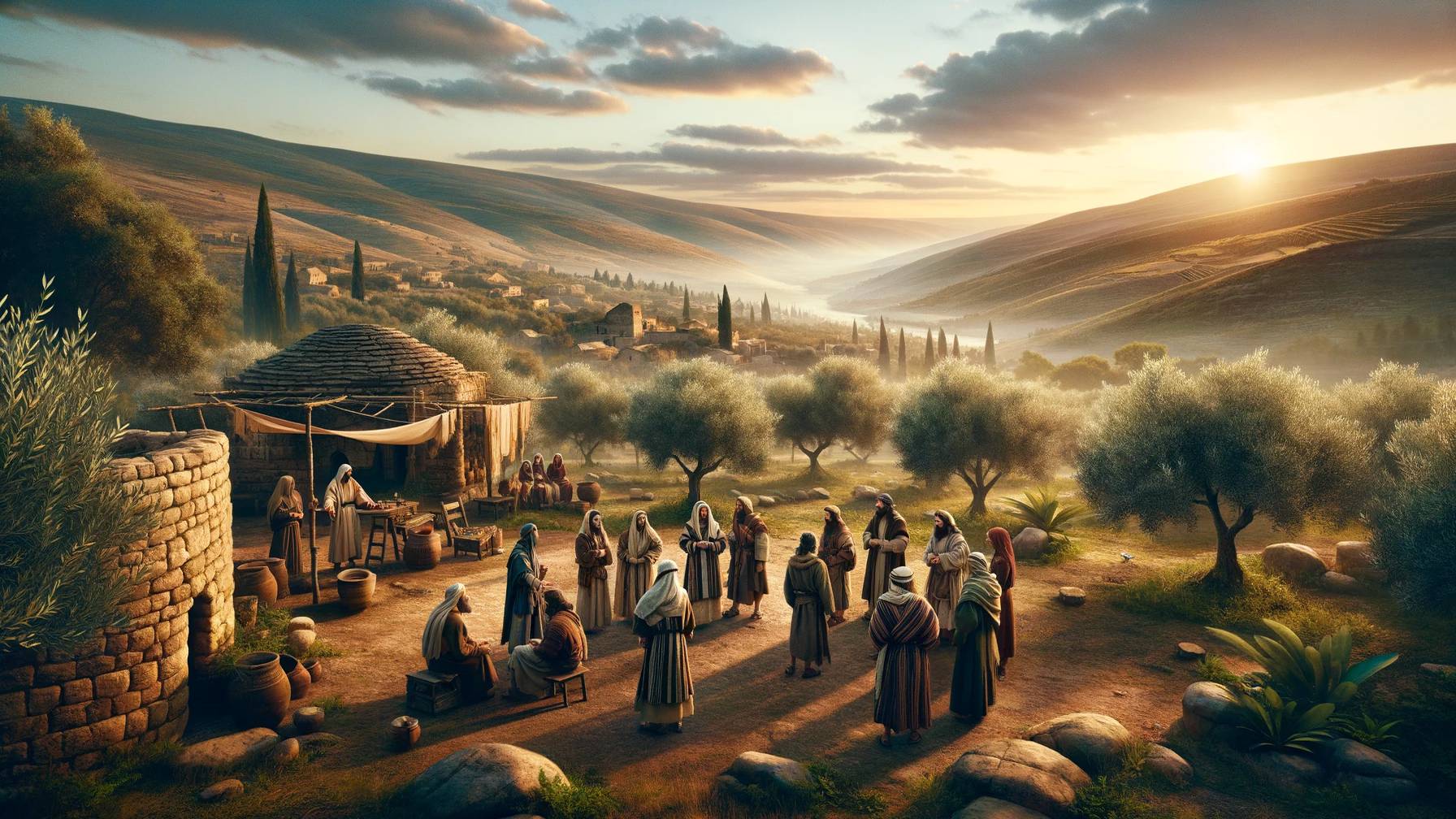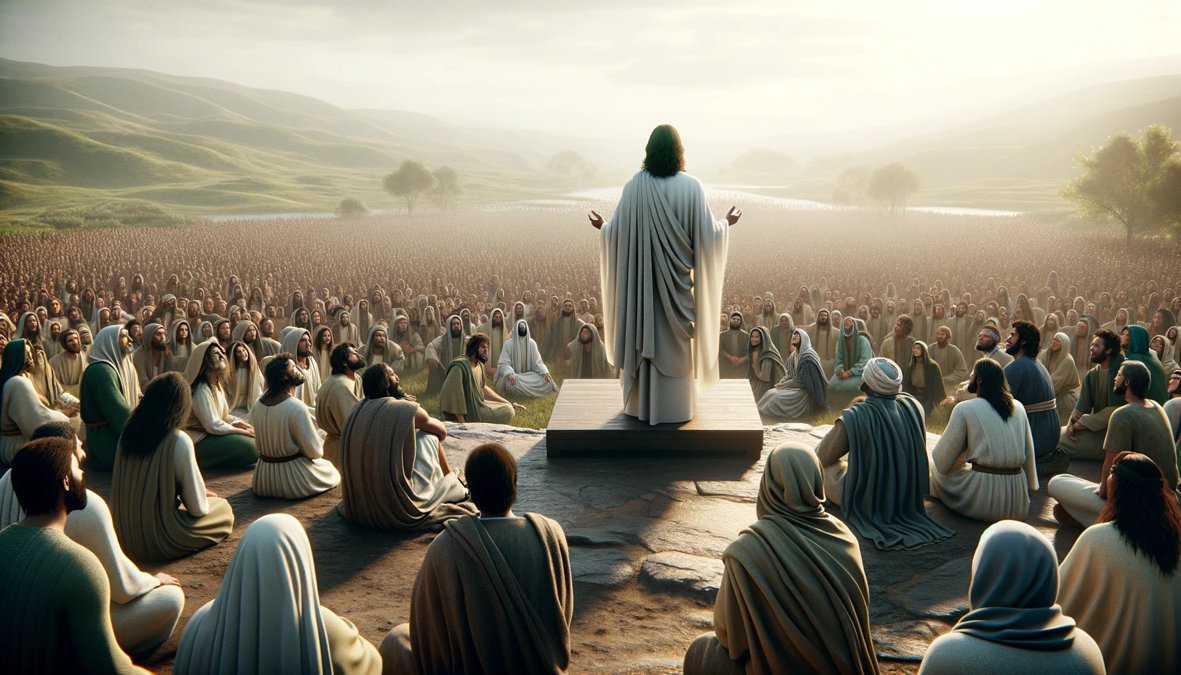Home>Christian Videos>Bible Stories>What Ethnicity Was Jesus Christ


Bible Stories
What Ethnicity Was Jesus Christ
Published: February 29, 2024
Ericka Andersen, an editor at Christian.net, expertly merges digital strategy with content creation, focusing on faith and societal issues. Her communication skills enhance the platform's engaging narratives, fostering meaningful dialogue on belief's impact on society.
Discover the truth about Jesus Christ's ethnicity and explore the Bible stories that shed light on his background. Uncover the historical and cultural context of Jesus's life.
(Many of the links in this article redirect to a specific reviewed product. Your purchase of these products through affiliate links helps to generate commission for Christian.net, at no extra cost. Learn more)
Table of Contents
The Historical Context of Jesus Christ's Ethnicity
The historical context of Jesus Christ's ethnicity is a topic that has intrigued scholars, theologians, and believers for centuries. Understanding the ethnicity of Jesus Christ is essential for gaining insight into the cultural, social, and religious milieu in which he lived and preached. Jesus Christ was born in the region of Judea, which was part of the Roman Empire during the 1st century. This period was characterized by a diverse population, including Jews, Romans, Greeks, and other ethnic groups. The ethnic diversity of the region played a significant role in shaping Jesus Christ's teachings and interactions with various communities.
-
Multicultural Environment: The region where Jesus Christ lived was a melting pot of different ethnicities, languages, and religious beliefs. This multicultural environment influenced Jesus Christ's ministry and the way he communicated his message to people from diverse backgrounds.
-
Political and Social Dynamics: The Roman occupation of Judea and the complex social dynamics of the time had a profound impact on Jesus Christ's life and mission. Understanding the historical context of Jesus Christ's ethnicity helps us comprehend the challenges he faced and the broader implications of his teachings within the socio-political landscape of 1st-century Judea.
-
Religious Interactions: Jesus Christ's ethnicity is intricately connected to the religious interactions of his time. The presence of Jewish religious traditions, as well as the influence of Hellenistic culture, contributed to the rich tapestry of beliefs and practices that shaped Jesus Christ's identity and teachings.
-
Cultural Influences: Exploring the historical context of Jesus Christ's ethnicity allows us to delve into the cultural influences that shaped his worldview and the way he engaged with people from different ethnic backgrounds. His ability to bridge cultural divides and connect with individuals from various ethnicities is a testament to the inclusive nature of his message.
-
Impact on Modern Understanding: By examining the historical context of Jesus Christ's ethnicity, we can gain a deeper appreciation for the universal relevance of his teachings and the enduring impact of his life within a diverse and interconnected world.
Understanding the historical context of Jesus Christ's ethnicity provides valuable insights into the complexities of his time and the enduring significance of his message in a multicultural world.
Read more: What Was Jesus Christ’s Profession
The Debate Over Jesus Christ's Ethnicity
The debate over Jesus Christ's ethnicity has been a subject of scholarly inquiry and theological discourse for centuries. The diverse interpretations and perspectives surrounding Jesus Christ's ethnicity have given rise to a rich tapestry of debates, theories, and speculations. This ongoing debate is fueled by a myriad of factors, including historical, cultural, religious, and sociopolitical considerations. The central question that underpins this debate revolves around the ethnic identity of Jesus Christ and its implications for understanding his life, teachings, and legacy. The debate over Jesus Christ's ethnicity encompasses a wide range of viewpoints, each offering unique insights and interpretations that contribute to the complex mosaic of scholarly discourse and religious contemplation.
Theological Interpretations
The debate over Jesus Christ's ethnicity is deeply intertwined with theological interpretations of his identity and mission. The theological perspectives on Jesus Christ's ethnicity vary across different Christian denominations and theological traditions. Some theological interpretations emphasize the universal significance of Jesus Christ's message, transcending ethnic boundaries, while others underscore the specific cultural and historical context of Jesus Christ's incarnation within a particular ethnic milieu.
Historical and Archaeological Evidence
The debate over Jesus Christ's ethnicity also engages with historical and archaeological evidence from the 1st century. Scholars and researchers analyze ancient texts, artifacts, and archaeological findings to glean insights into the ethnic and cultural milieu of Judea during Jesus Christ's lifetime. This evidence is scrutinized and interpreted through various lenses, contributing to the multifaceted nature of the debate over Jesus Christ's ethnicity.
Cultural and Sociopolitical Context
The cultural and sociopolitical context of 1st-century Judea forms a crucial backdrop for the debate over Jesus Christ's ethnicity. The complex interplay of ethnic, religious, and political dynamics in the region during that era adds layers of complexity to the discourse surrounding Jesus Christ's ethnicity. Understanding the cultural and sociopolitical context is essential for contextualizing the diverse perspectives and interpretations that shape the ongoing debate.
Read more: What Is Jesus Christ’s Religion
Contemporary Implications
The debate over Jesus Christ's ethnicity extends beyond historical and theological realms to encompass contemporary implications. Discussions about Jesus Christ's ethnicity resonate with contemporary issues of diversity, inclusivity, and cultural identity. The ongoing debate prompts reflection on the universal relevance of Jesus Christ's message in a multicultural world and its implications for fostering understanding and harmony across diverse ethnic and cultural landscapes.
Interdisciplinary Dialogue
The debate over Jesus Christ's ethnicity fosters interdisciplinary dialogue, bringing together scholars from diverse fields, including history, archaeology, theology, anthropology, and cultural studies. This interdisciplinary exchange of ideas enriches the discourse, offering a holistic approach to understanding the multifaceted dimensions of Jesus Christ's ethnicity and its broader significance.
The debate over Jesus Christ's ethnicity continues to inspire rigorous inquiry, contemplation, and dialogue, reflecting the enduring fascination with unraveling the complexities of Jesus Christ's identity within the rich tapestry of human history and religious thought.
Evidence from Biblical and Historical Sources
The quest to discern the ethnicity of Jesus Christ draws heavily upon evidence from biblical and historical sources, offering a multifaceted lens through which scholars and theologians seek to unravel the enigma of Jesus Christ's ethnic identity.
-
Biblical Accounts: The New Testament, particularly the Gospels of Matthew, Mark, Luke, and John, serves as a primary source for understanding the life and ministry of Jesus Christ. These accounts provide insights into Jesus Christ's interactions with individuals from diverse ethnic backgrounds, shedding light on the inclusive nature of his message and its resonance across different cultural contexts.
-
Cultural and Linguistic Context: The linguistic and cultural nuances embedded in the biblical narratives offer valuable clues regarding Jesus Christ's ethnicity. Exploring the language, customs, and societal norms prevalent in 1st-century Judea provides a contextual framework for understanding the ethnic milieu in which Jesus Christ lived and preached.
-
Historical Documentation: Beyond the biblical texts, historical documentation from the 1st century contributes to the mosaic of evidence surrounding Jesus Christ's ethnicity. Roman historical records, Jewish writings, and accounts from contemporary historians offer glimpses into the diverse ethnic landscape of Judea, enriching our understanding of the cultural tapestry within which Jesus Christ's life unfolded.
-
Archaeological Findings: Archaeological excavations in the region of ancient Judea yield tangible artifacts and inscriptions that provide tangible links to the ethnic and cultural dynamics of Jesus Christ's era. These findings offer tangible manifestations of the diverse ethnic groups and cultural influences that shaped the societal backdrop of Jesus Christ's time.
-
Extrabiblical Texts: Extrabiblical texts, including ancient manuscripts and writings from the 1st century, offer supplementary insights into the ethnic and cultural context of Jesus Christ's era. These texts, ranging from Jewish writings to Hellenistic literature, contribute to a broader tapestry of evidence that informs scholarly inquiry into Jesus Christ's ethnicity.
-
Interdisciplinary Analysis: Interdisciplinary analysis of biblical and historical sources, incorporating insights from fields such as archaeology, linguistics, and ancient history, enriches the exploration of Jesus Christ's ethnicity. This holistic approach fosters a nuanced understanding of the multifaceted evidence that converges to illuminate the ethnic identity of Jesus Christ within the rich tapestry of 1st-century Judea.
The convergence of evidence from biblical and historical sources forms a compelling foundation for scholarly inquiry into the ethnicity of Jesus Christ, inviting a multidimensional exploration of the cultural, linguistic, and historical dimensions that shape our understanding of the enigmatic figure who continues to inspire and captivate hearts and minds across the ages.
The Cultural and Geographical Background of Jesus Christ
The cultural and geographical background of Jesus Christ encompasses a rich tapestry of historical, social, and religious dimensions that provide essential context for understanding his ethnic identity.
-
Judean Society: Jesus Christ was born and raised in the region of Judea, a land steeped in the traditions of Judaism. The cultural fabric of Judea was woven with the threads of Jewish religious practices, customs, and beliefs, shaping the societal landscape within which Jesus Christ's life unfolded.
-
Mosaic of Ethnicities: Judea was a melting pot of diverse ethnicities, including Jews, Romans, Greeks, and other groups. This multicultural milieu fostered a dynamic interplay of cultural exchanges, religious interactions, and linguistic diversity, offering a vibrant backdrop for Jesus Christ's teachings and interactions with individuals from varied ethnic backgrounds.
-
Galilean Context: Jesus Christ's upbringing in the Galilean region further enriched his cultural and geographical background. Galilee was characterized by its own distinct cultural and linguistic features, contributing to the multifaceted identity of Jesus Christ within the broader context of 1st-century Judea.
-
Hellenistic Influences: The pervasive influence of Hellenistic culture, stemming from the conquests of Alexander the Great, permeated the cultural and intellectual milieu of the Eastern Mediterranean, including Judea. The interplay between Jewish traditions and Hellenistic influences added layers of complexity to the cultural and geographical backdrop against which Jesus Christ's life unfolded.
-
Geographical Landscapes: The diverse geographical landscapes of Judea, encompassing rugged terrains, fertile valleys, and bustling urban centers, shaped the lived experiences of the people in Jesus Christ's era. These varied landscapes influenced the cultural practices, economic activities, and social dynamics that formed an integral part of Jesus Christ's cultural and geographical background.
-
Cultural Synthesis: Jesus Christ's ministry reflected a remarkable ability to bridge cultural divides and engage with individuals from diverse ethnic and geographical backgrounds. His teachings and parables often drew upon familiar cultural and geographical elements, resonating with the everyday experiences of his audience and transcending ethnic boundaries.
-
Cultural Resonance: The cultural and geographical background of Jesus Christ underscores the universal resonance of his message, which transcends specific ethnic or geographical confines. His teachings continue to inspire and resonate with individuals from diverse cultural and geographical contexts, reflecting the enduring impact of his life within the rich tapestry of human experience.
The cultural and geographical background of Jesus Christ provides a multifaceted lens through which to appreciate the complexities of his identity and the enduring relevance of his message within the diverse and interconnected world of the 21st century.
Read more: What Is The Transfiguration Of Jesus Christ
The Significance of Jesus Christ's Ethnicity Today
The significance of Jesus Christ's ethnicity today reverberates across diverse spheres, encompassing theological, cultural, and social dimensions that continue to shape contemporary discourse and contemplation.
-
Theological Reflection: Jesus Christ's ethnicity holds theological significance, prompting reflection on the incarnation of the divine within a specific ethnic and cultural context. This theological contemplation invites individuals to consider the universal implications of Jesus Christ's message while acknowledging the particularity of his historical and ethnic identity.
-
Cultural Diversity: In an increasingly interconnected world marked by cultural diversity, Jesus Christ's ethnicity serves as a symbol of inclusivity and transcultural resonance. His ability to engage with individuals from diverse ethnic backgrounds underscores the universal relevance of his teachings, fostering dialogue and understanding across cultural divides.
-
Interfaith Dialogue: Jesus Christ's ethnicity serves as a focal point for interfaith dialogue, prompting conversations about the intersections of religious traditions, cultural heritage, and ethnic identities. His life and teachings inspire discussions that transcend religious boundaries, fostering mutual respect and cooperation among diverse faith communities.
-
Historical Context: Understanding Jesus Christ's ethnicity enriches historical scholarship, offering insights into the cultural, social, and religious dynamics of 1st-century Judea. This historical context provides a nuanced backdrop for interpreting the enduring impact of Jesus Christ's life and teachings within the tapestry of human history.
-
Social Relevance: Jesus Christ's ethnicity resonates with contemporary discussions on social justice, equity, and inclusivity. His embrace of individuals from marginalized and diverse ethnic backgrounds serves as a timeless example of compassion and solidarity, inspiring efforts to address societal challenges related to ethnicity and cultural diversity.
-
Cultural Heritage: Jesus Christ's ethnicity contributes to the cultural heritage of diverse communities, serving as a source of inspiration, identity, and artistic expression. His portrayal in various cultural and artistic traditions reflects the enduring impact of his life and teachings on the collective imagination of diverse ethnic and cultural groups.
-
Ethical Reflection: Jesus Christ's ethnicity prompts ethical reflection on issues of prejudice, discrimination, and the affirmation of human dignity across ethnic boundaries. His teachings on love, compassion, and the inherent worth of every individual resonate with contemporary efforts to promote understanding and harmony in multicultural societies.
The significance of Jesus Christ's ethnicity today transcends temporal and spatial confines, inviting individuals and communities to engage with the enduring legacy of his life and teachings within the rich tapestry of human diversity and interconnectedness.













